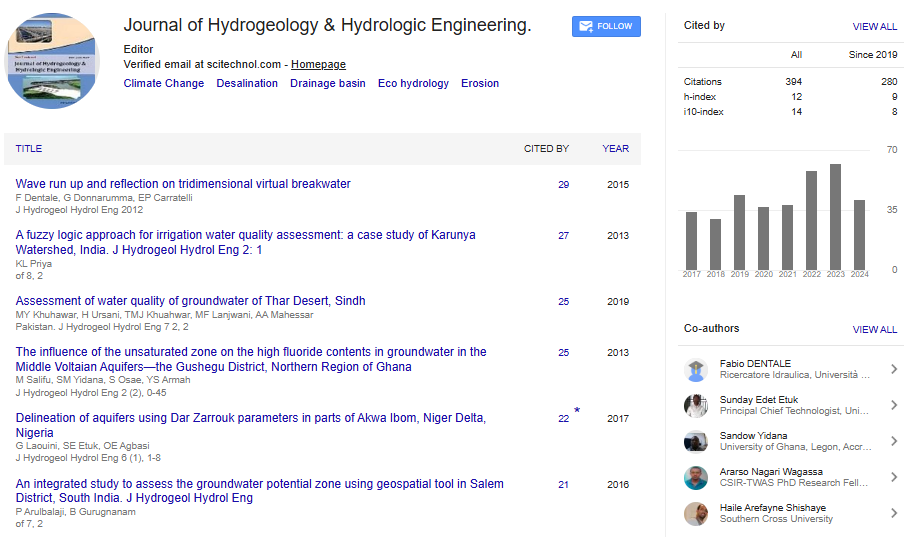Opinion Article, J Hydrogeol Hydrol Eng Vol: 13 Issue: 5
Effective Strategies for Erosion and Sedimentation Control in Environmental Management
Fiona Mitchell*
1Department of Ecohydrology, University of Dhaka, Dhaka, Bangladesh
*Corresponding Author: Fiona Mitchell,
Department of Ecohydrology, University
of Dhaka, Dhaka, Bangladesh
E-mail: mitchellf45@gmail.com
Received date: 23 September, 2024, Manuscript No. JHHE-24-153111;
Editor assigned date: 25 September, 2024, PreQC No. JHHE-24-153111 (PQ);
Reviewed date: 09 October, 2024, QC No. JHHE-24-153111;
Revised date: 16 October, 2024, Manuscript No. JHHE-24-153111 (R);
Published date: 24 October, 2024, DOI: 10.4172/2325-9647.1000347
Citation: Ogunka-Nnoka CU, Ben-Piakor TE, Mepba HD, Ifeanacho MO (2020) Effect of Processing on Phytochemicals and Nutrient Composition of Tiger Nut (Cyperus esculentus L). J Food Nutr Disor 9:2. doi: 10.37532/jfnd.2020.9(2).271
Description
Erosion and sedimentation are natural processes that shape landscapes over time. However, when accelerated by human activities like construction, deforestation, or agriculture, these processes can lead to serious environmental and infrastructure issues. Erosion can strip the land of fertile soil, diminish agricultural productivity and degrade water quality, while sedimentation can clog waterways, increase flood risks and harm aquatic habitats. Therefore, implementing effective erosion and sedimentation control strategies is precarious for sustainable land management and environmental protection.
Erosion involves the removal of soil particles by wind, water, or gravity. It’s a natural process but can be exacerbated by activities such as mining, road building and agriculture. Sedimentation, on the other hand, is the deposition of eroded particles in new locations, often in rivers, lakes and reservoirs. While some sedimentation is beneficial for building deltas and replenishing soil, excessive sediment loads can harm ecosystems, reduce water quality and impair hydraulic structures.
Without proper erosion and sediment control measures, both natural and urbanized areas are at risk. Unchecked erosion can deplete topsoil, reduce plant growth and destabilize slopes, leading to landslides. In turn, sediment-laden runoff can damage water bodies, alter flow patterns and disrupt aquatic life. Given the environmental and financial costs associated with erosion and sedimentation, effective control strategies are essential for land managers, engineers and developers.
Establishing vegetation on bare soils is one of the most effective and natural ways to prevent erosion. Plant roots help bind the soil, reducing its vulnerability to wind and water forces. Grass, shrubs and trees are commonly used as cover and native species are preferred due to their adaptability to local climate and soil conditions. In steep areas or construction sites, temporary vegetative cover can be planted to stabilize soil until permanent vegetation takes root.
Structural measures like retaining walls, silt fences and sediment basins are widely used to control sedimentation in construction and industrial sites. These structures slow down runoff, allowing sediments to settle before water is discharged into nearby streams or rivers. Retaining walls provide structural support on slopes, while silt fences prevent soil from leaving construction sites. Sediment basins, on the other hand, capture large volumes of runoff, providing time for particles to settle before the water continues downstream.
In areas where vegetation alone cannot stabilize soil, erosion control blankets and mulching are valuable alternatives. Blankets made from natural or synthetic fibers are placed over the soil to protect it from wind and water erosion, often used on steep slopes or newly graded sites. Mulching, on the other hand, involves applying a layer of organic material like straw or wood chips over bare soil. Mulch reduces the impact of raindrops on the soil and helps retain moisture, supporting seed germination and plant growth.
For agricultural landscapes, contour plowing and terracing are highly effective erosion control methods. Contour plowing involves plowing along the contours of a slope to create ridges that slow down water flow, reducing soil erosion. Terracing, a more intensive method, transforms a slope into a series of flat platforms or steps. This technique minimizes runoff, prevents soil loss and allows crops to grow on otherwise unworkable hillsides.
Buffer zones, areas of vegetation between farmland or developed areas and bodies of water, play an essential role in trapping sediment before it reaches streams or rivers. Riparian vegetation (plants along water bodies) not only acts as a physical barrier to sediment flow but also stabilizes banks, preventing streambank erosion. These buffers enhance water quality by filtering pollutants and providing habitat for wildlife.
Despite the effectiveness of these strategies, there are challenges in erosion and sedimentation control, including high implementation costs, maintenance demands and the need for site-specific solutions. Some methods, like vegetation cover, are susceptible to seasonal changes, requiring adaptive management. Additionally, in highly developed or densely populated areas, space for implementing erosion control measures may be limited and land managers must work with other stakeholders to optimize land use. Innovations in remote sensing and monitoring technologies are helping to address these challenges by allowing for real-time tracking of erosion patterns and sediment movement.
Conclusion
Effective erosion and sedimentation control is essential for protecting landscapes, preserving soil resources and maintaining healthy water ecosystems. By combining strategies such as vegetative cover, structural controls and innovative agricultural practices, land managers can significantly reduce the adverse impacts of these natural processes. While challenges remain, the integration of modern technology and sustainable materials offers promising opportunities for improved erosion and sediment control in the future. As communities become more aware of the environmental and economic importance of soil conservation, erosion and sedimentation control will continue to be an essential component of environmental management.
 Spanish
Spanish  Chinese
Chinese  Russian
Russian  German
German  French
French  Japanese
Japanese  Portuguese
Portuguese  Hindi
Hindi 
